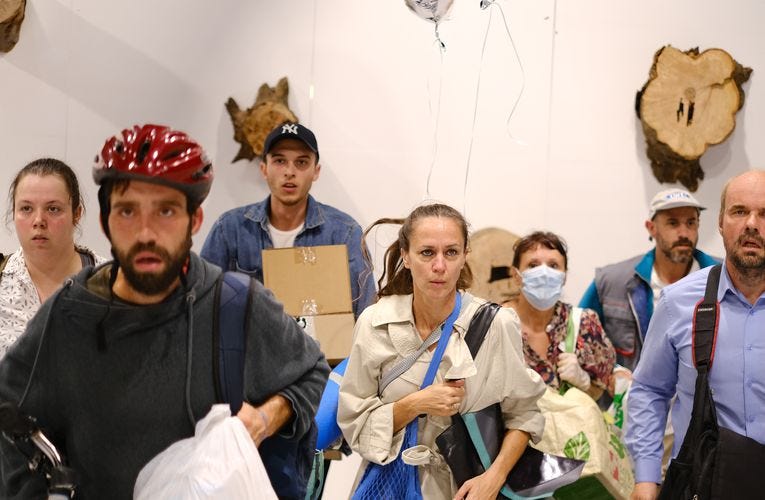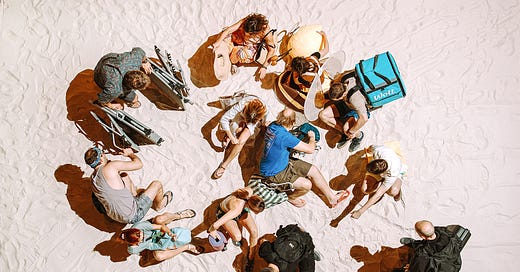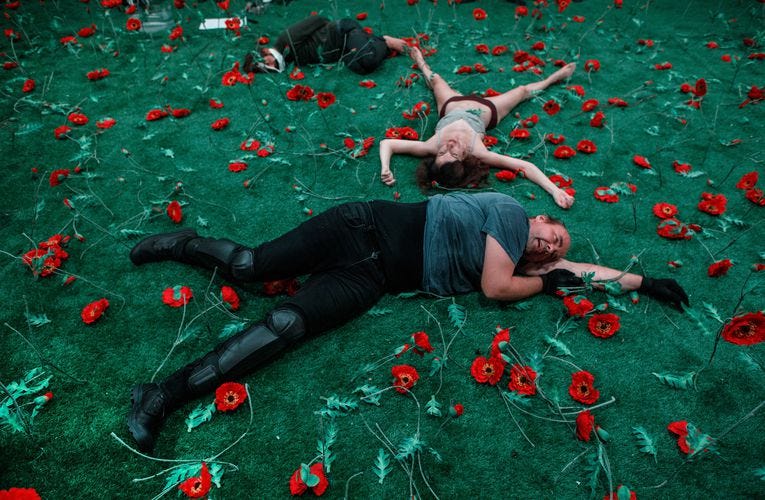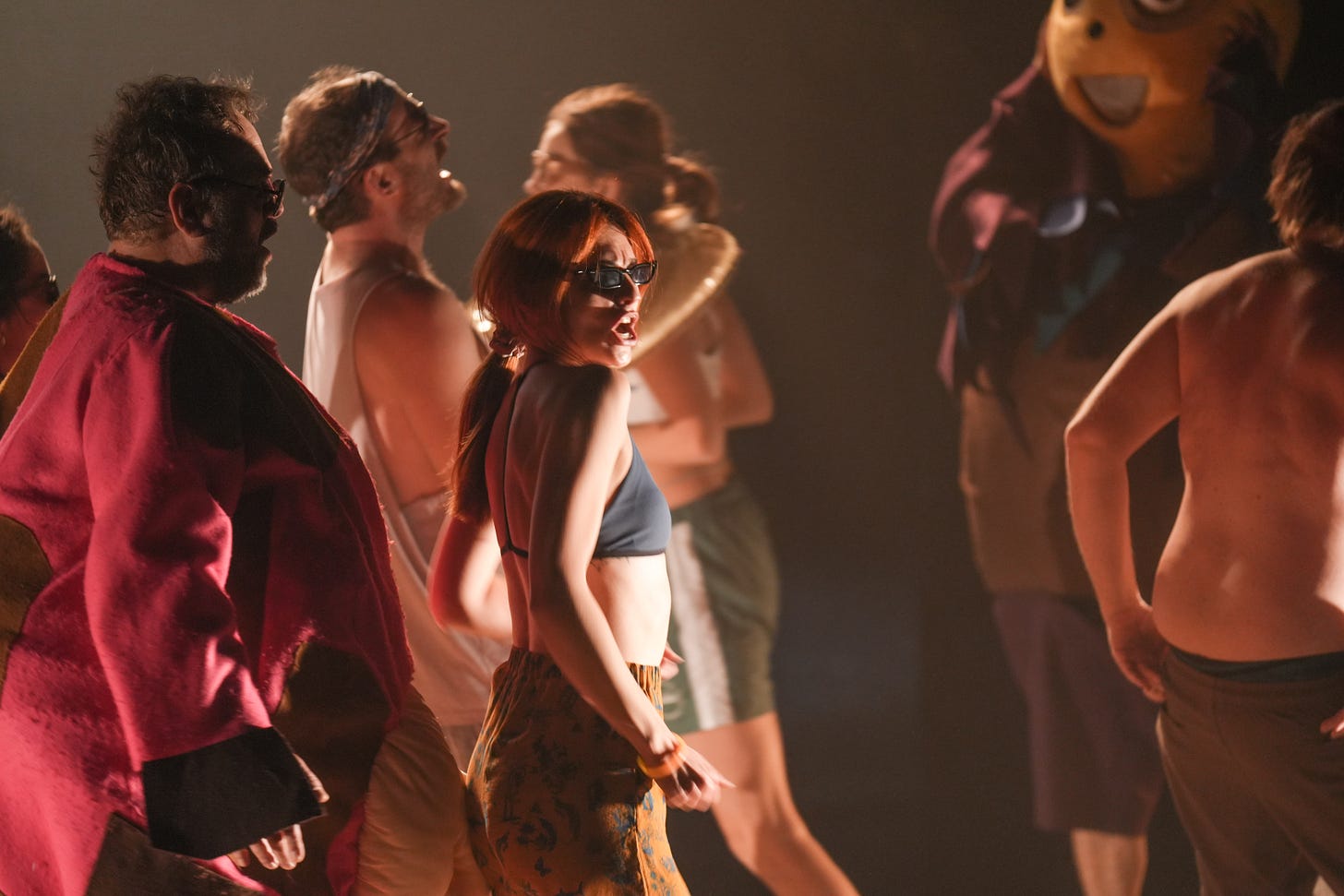On the beach: the eco theatre of Žiga Divjak
On a young Slovenian director finding new forms to explore the climate crisis on stage.
Welcome to Café Europa, a weekly newsletter dedicated to European theatre.
Happy new year. I hope the festive season treated you well (or in is treating you well, since the holidays are still underway in many places in the Balkans and beyond). This year I hope to spread my net more widely while, wherever possible travelling overland (I spent a lot of time on buses in 2023). There will be more interviews, more reviews, and no doubt more buses, plus bonus editions for paid subscribers. To kick things off, I want to talk about the work of one of the breakout stars of the Slovenian theatre scene.
If you enjoy reading this newsletter, then please consider sharing it. If you really enjoy it and want to become a paid supporter, that would be lovely. It really makes a difference and will allow me to expand my coverage. As is the way these days, I also have a Ko-fi account.
It’s mid-December and I am watching a man in a cow costume dance vigorously to the Macarena. This is par for the course in the UK where it’s the height of pantomime season, but I’m not in the UK, I’m in Belgrade watching the premiere of The Future, a new show by Žiga Divjak, a young Slovenian director whose brand of socially engaged, formerly inventive theatre has made him a name to watch in the region.
The Future is inspired by a 2020 novel The Ministry of The Future by Kim Stanley Robinson. It’s a not a book I’m familiar with, but it’s variously described as hard sci-fi or climate fiction (cli-fi). Thematically this is not a surprise. Much of Divjak’s work explores climate catastrophe, humanity’s impact on the planet and the systems in which we live.
Only connect
These preoccupations were evident in The Man Who Watched the World, made for Mladinsko Theatre when he was fresh out of the University of Ljubljana. I saw this show in 2017, and it made an impression on me. The performance consisted of a series of scenes that all in some way explored what it is like to be part of the capitalist machine, to live without economic or environmental stability. Two Chinese factory workers make their annual trip home for New Year, their whole existence driven by their wish to ensure their children have more opportunities than they did; an Indian farmer decides to start planting GM cotton in an effort to rescue himself from debt; a woman attempts to celebrate her 40th birthday, only to ends up being nagged by her aunt about the fact she hasn’t had children yet. All of these seemingly disparate scenes are interconnected. Everyone is struggling to find work, to stay afloat, to cope as an artist, to survive in a brutal capitalistic system. It was relentless and tiring piece to watch, but this was in keeping with the experiences it was depicting.
Fever dreams
Later performances were more explicitly about the climate crisis. Inspired by Andreas Malm’s How to Blow up a Pipeline, his 2021 show Fever is an intriguing fusion of documentary and choral techniques. It takes place in a large plastic tent, a bit like a hothouse, with the audience sitting around a lawn of red flowers, the actors dispersed among us. We are assailed with data about the catastrophic damage being done to the environment and the consequences of this damage, while actor Vito Weis locks eyes with the audience, imploring them to join him in his activism, to take radical, even violent action if needs be, before being pinned down by two men dressed in riot gear. This scene plays out again and again (Repetition is a tool that Divjak uses frequently). We are also presented with more personal stories. One older female performer talks about her complicity in climate change from the viewpoint of a generation who are now being blamed for the destruction of the planet, exploring how the experience of deprivation coupled with a desire to make a better life for your children has contributed to place in which we find ourselves. By the end the flowers have been trampled.
Other work has tackled what is unhelpfully often labelled the ‘migrant crisis’ in the Balkans head on. His 2018 show 6 is based on real-life experience of a group of six refugee children from Afghanistan and Syria who found themselves in a school in a small provincial town in Slovenia, sparking protests among parents, who didn’t want them there. The Game, which I wrote about in more detail in an earlier issue, is a devised piece which draws on data from the Border Violence Monitoring Network to depicts the aggressive way Europe polices its borders by pushing people back into Bosnia, often beating and humiliating them in the process.
While a lot of his work is devised, Divjak also works with text, often collaborating with playwright Katarina Morano. His production of her play Sediment for City Theatre Ljubljana, about a group of siblings slowly packing up their late mother’s flat, was a favourite of mine when I saw it at last year’s Maribor Festival. He also staged one of Europe’s many productions of Duncan Macmillan’s Lungs, a play in which a couple wrestle with the question of whether to have kids, for the National Drama Theatre in Ljubljana; over the course of the play, a large block of ice slowly melted, dripping over the couple’s devices.

In 2022, he premiered a new work in Belgrade during BITEF, another co-production with Mladinsko Theatre, called Crises. Drawing on Jason Hickel’s Less is More: How Degrowth will Save the World, Anna Tsing’s book The Mushroom at the End of the World. It was an intensely physical performance. Seven performers, naked or near-naked, to begin with enter the stage and start running on the spot. As they do this, they gradually dress themselves and acquire more and more stuff: handbags, shopping bags, backpacks, disposable coffee cups, children’s toys, helium balloons, Amazon parcels, like human Buckaroo. They never stop running, getting sweatier and sweatier, redder and redder in the face, while an audio essay drawing on both texts is relayed to us in Adam Curtis-esque voiceover. Divjak keeps them running for a good 45 minutes, acquiring and discarding items along the way, and just when you wonder how they are going to physically sustain this punishing performance, it shifts gears. During the final fifteen minutes the performers lay on the floor of a post-apocalyptically lit stage, tenderly assisting each other to eat and drink and smoke cigarettes. I was not alone in feeling that the way their bodies are contorted, with the implication of missing limbs problematic, but the potency of these images, of care and cooperation in the wake of disaster, was considerable.
One word I’ve heard in relation to Divjak’s work is ‘guilt’, that his work is designed to evoke guilt in his audience, to make them feel uncomfortable. Arguably guilt is a by-product of his work. It’s not meant to make us feel comfortable, certainly, but when I interviewed him in 2022, he said he wanted people to feel “angry not guilty,” to feel fury at the exploitative systems in which we are trapped, systems that drive us to consume, to acquire, to constantly replace and upgrade the things we own. (“In-built obsolescence is a crime against humanity.”)
Back to The Future
The Future, a co-production between City Theatre Ljubljana and Belgrade Drama Theatre, feels like an extension of or companion piece to Crises. The front section of the stage is covered in sand. On the back wall of the theatre surtitles are projected. The show is composed of a series of vignettes. There is no plot. No dialogue. A group of people trailing wheeled suitcases line up on stage and, one by one, proceed to take a run at the sand, ploughing into it. They repeat this with greater degrees of enthusiasm.
Next everyone lays out their beach towels on the sand, marking out their own little patch of beach. Then they start to pair up, assessing the terrain for a suitable mate; once no one is uncoupled it becomes necessary to push someone aside in order to find a pair. The usurped sunbather must, in turn, supplant someone else. This goes in for a while, with one person supplanting another. Between each round of musical beach towels, everyone waggles their bare feet (maybe some kind of bird-related mating dance?).
In another sequence everyone on stage becomes hotter and hotter, vigorously fanning themselves while a gaggle of increasingly frustrated men try and fail to successfully erect a beach umbrella. Later everyone stands at the edge of the sand and starts calling out the name of their presumably missing children. (As this review points out, this raw chorus hits all the harder in a theatre situated in the same neighbourhood as the school in which nine children were killed by a teenager earlier this year, the ramifications of which are still being felt in Serbia).
Shifts in lighting change the beach setting from idyllic to ominous. A couple lugging suitcases behind them try in vain to contact someone, a people smuggler perhaps. The beach is no longer a destination for pleasure, but a place of suspense and peril.
In between the vignettes, a man in a black t-shirt with a bird on it comes and rakes the sand smooth and disposes of everyone else’s litter, bagging it and depositing it at the front of the stage as the surtitles inform us about the impact of plastics on the environment and the plight of the albatross.
If you’ve seen it’s hard not to compare the show with Sun and Sea, the Lithuanian climate change opera/installation which also used a beach scene to explore similar topics, but while he uses similar imagery, he uses it to very different ends. The most memorable scene sees the cast don outsize animal costumes - a cow, a bee - and play the Macarena on a portable speaker. They do all the moves, they go full beach party, against a backdrop littered with beach inflatables. Once the song reaches the end, they do it all over again. You sit there and wonder, are they really going to play the whole thing twice? And, oh yes, they do. Then the party evaporates and a dazed-looking man in military uniform wanders on stage, gun in hand. He unlaces his boots and places his feet in the soft sand, and does a kind of blank-eyed, traumatised dance.
In the final bleakly amusing scene, his group of tourists scamper across the sand in an effort to catch a boat which is leaving without them. They are, inevitably too late.
This was not, to my mind, the strongest of Divjak’s shows. It didn’t have Crises gripping physicality and felt unusually baggy (and I would be a lying liar if I said I didn’t find myself thinking about Willa’s play Sands in Succession a couple of times during the show). Yet when viewed as part of a body of work it, the show is yet another example of a director continually and committedly willing to grapple with the existential questions facing us as a species - displacement, migration, exploitation of labour, climate crisis and all the many ways in which they are connected - with formal rigour and a necessary sense of urgency.
This week in European theatre
A round-up of festivals, premieres and other exciting upcoming events.
The Hills Are Alive – This new show by puppeteers Nikolaus Habjan and Neville Tranter, about an elderly couple who left Austria for the US, fleeing the Nazis with their large brood of children, and who now find themselves living in post-Trump America, sounds like an absolute blast. It premieres at the Deutschestheater in Berlin on 6 January.
The Effect – Jamie Lloyd’s intense revival of Lucy Prebble’s play about a couple who meet - and, maybe, fall in love - in a drug testing facility, starring Paapa Essiedu and Canadian actor Taylor Russell will transfer to the Shed in New York later this year, following its run at the National Theatre London, but it will be possible to watch it on NT at Home from 9 January,
Judas – Starring the incomparable Hans Kesting, Robert Icke’s production for ITA, which splices together the gospels of Matthew, Luke and John with the story of Judas in typically Icke-ian fashion, returns to the Internationaal Theater Amsterdam for the last time between 10-20 January.
Thanks for reading!
If you have any feedback, recommendations, tips, or thoughts about this newsletter, you can reach me on natasha.tripney@gmail.com






